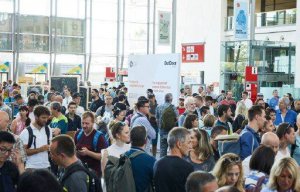
OutDoor by ISPO moves to October
The two-day event included presentations from leading experts on subjects that included biomimicry, plus digital design, and more.
withconferenceco-organisersJoanneHarris(left)andJoConlon(right)-612x408-boxed.jpg)
2nd May 2018
Innovation in Textiles
|
Huddersfield
The Transitions 2: Material Revolution conference at the University of Huddersfield assembled academics, entrepreneurs, designers and textiles manufacturers from around the world, who are pioneering the use of new materials and who are passionate about environmental sustainability.
The two-day event included presentations from leading experts on subjects that included biomimicry – the development of environmentally-friendly textiles inspired by nature – plus digital design, artificial intelligence and the circular economy, which aims to ensure that textiles manufacturing makes no damaging impact on the environment.
There were speakers from some 15 firms and consultancies operating in fields such as advanced manufacturing and digital technology. There were also presentations from a similar number of academic researchers, based at universities and institutes around the world, in countries that included the USA, Holland, Kenya and Germany. There was a total of 95 delegates.
“We have bridged the gap between academia and industry and created a new, original energy to come out of an academic conference,” said co-organiser Joanne Harris, who is a Senior Lecturer at the University of Huddersfield’s Department of Fashion and Textiles. She added that the University – where she is Course Leader for MA Fashion Textile Practices and MA International Fashion Design Management – is producing students fully equipped to work in the modern textiles sector.
Co-organiser Jo Conlon – a Senior Lecturer who is Course Leader for the Fashion Image, Communication and Buying degree courses – said that partnerships between academia and the business world were the most important outcome of the conference.
The conference was opened by the University of Huddersfield’s Professor Parik Goswami, who heads the Department of Fashion and Textiles. He stressed the importance of inter-disciplinary research in the textiles field, stating that in his department the boundaries would be “absolutely porous” and that he was determined to work closely with industry.
Professor Goswami described some of the new facilities, such as a state-of-the-art textile testing lab, that the department was acquiring, and he introduced a film narrated by the University’s Emeritus Chancellor, Sir Patrick Stewart, which previewed the £30 million Hepworth Building, currently under construction as a new base for the School of Art, Design and Architecture.
The first keynote address came from Jenny Sabin, an Assistant Professor at the USA’s Cornell University and Principal of the Sabin Design Lab. She is renowned for research that applies insights and theories from biology and mathematics to the design of material structures. She described some of her most impressive architectural projects, including the use of bio-materials. “Jenny Sabin’s work is a great example of trans-disciplinary research,” commented Joanne Harris. “But even in the most fantastic projects she is doing the key aim is to harmonise with humanity.”
The second keynote speaker was the UK-based Ben Hanson, senior analysis for the digital magazine WhichPLM, which furnishes advice to many of the world’s leading retailers, brands and manufacturers. He spoke on the digital transformation of design.
The third keynote address was from Joan Farrer, who is Professor of Design and Innovation at the University of Portsmouth. She is a designer who has worked with global brands and major organisations and carried out pioneering research in sustainable fashion textile global supply chain analysis. Her talk was titled Design Thinking and Transdisciplinarity: Methods for Innovation.
Transitions 2 had three main sessions, dealing with new material forms, digital futures and sustainable futures, that included presentations from key figures in their fields. Co-organiser Joanne Harris said that environmental impact was a thread running through the presentations.
“Although the conference was focussed on the materials revolution, the main message was that even big organisations need to know about issues such as product lifestyle management and the circular economy. Everything that we do needs to consider the environment of the planet.”
Jo Conlon said that another conference theme was the breaking down of “silos” that had separated the technical and the aesthetic dimensions of textiles. “Designers can be technical. And equally, we can use a design-thinking approach to solve inter-disciplinary problems.”

Business intelligence for the fibre, textiles and apparel industries: technologies, innovations, markets, investments, trade policy, sourcing, strategy...
Find out more